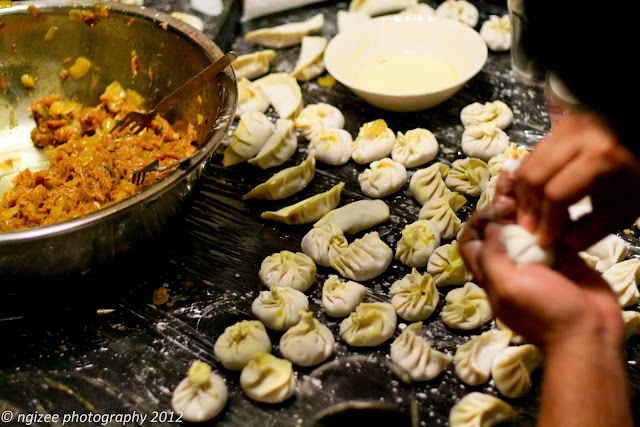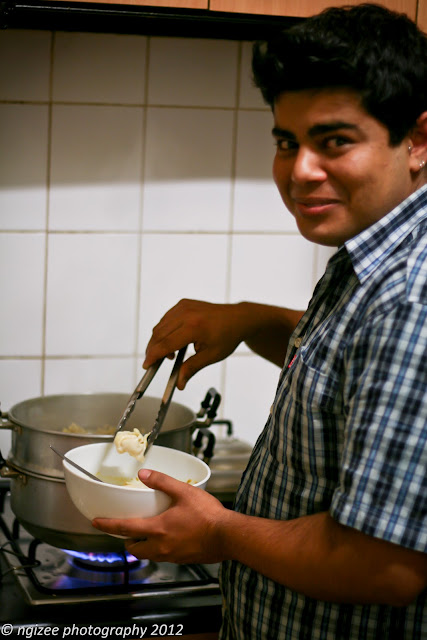
My friend Sooji (that's what I call him!) is from Nepal - home to Mount Everest - highest point on Earth (Sooji is not that tall though!). When it comes to cuisine, Nepal being landlocked by China and India, has a good mix of fusion dishes from these countries. Some of these dishes take their lead from both Chinese or Indian styles of cooking, and turn it into something unique. I have eaten the ever familiar curry and rice dishes at Nepalese restaurants and also had their version of stir fry. One thing that is a rarity in Melbourne though, is a Nepalese joint that serves good Momo. For those that don't know, the momo has a very similar likeness to Chinese or Japanese dumplings. The difference is that momo has a spicy curry masala that flavours the filling as opposed to the basic, and sometimes quite generic, dumpling mix. "And you can't say no no to some good momo"
Sooji has been going on about his home-made momo ever since I met him. We've eaten momo at a Nepalese cafe but he insists that their's is mediocre, compared to the way he and his housemates, from the homeland, make it. Recently, I finally received an invite to his place for momo. And as he put it - "Bring your appetite and come early, as momo at my place means you have to help make them too!" How could I turn down such an invitation - learn a new dish, take some pics and enjoy an evening feasting on authentic momo.
Sooji went a bit overboard and thought he was catering for an army - so I think we collectively whipped up over 350 of these delicious dumplings. There were leftovers for everyone to take-away. So whilst the pictures show the quantities from 3 kilograms of minced meat filling don't be dissuaded as I have scaled the recipe down to 1 kilogram. This should make between 90 - 100 momo and they freeze well too - if you have any leftovers. Generally, it's ten per serve, but on this night I had to put the brakes on after number 23 (Mind you that was within a span of 3 hours!)
 Directions
DirectionsFor the filling [STEP 1]
1kg x Minced Meat (we used a mixture of pork & chicken)
2tbsp x Momo Masala (Available at Indian grocers - we used Century brand)
2tbsp x Mustard Oil
1tbsp Ginger, grated
1tbsp x Garlic, crushed
2tbsp x Coriander leaves, chopped
Combine all ingredients in a large bowl, cover and marinate while you prepare the next step
[STEP 2]
1tbsp x Vegetable oil
1tsp x Cumin seeds
3 x Onions, finely diced
1tbsp x Ginger, grated
1tbsp x Garlic, crushed
1tsp x Turmeric powder
Heat the oil in a skillet then add the cumin seed and stir until they start to pop
Add the diced onion allow to sweat down for 5 minutes
Now add the ginger, garlic and turmeric and stir through
Cook for another 5 minutes, then allow to cool.
[STEP THREE]
Combine the onion mix with the meat
Then use your hands to mix everthing together
For the momo wrapper the most readily available is the Gyoza dumpling skins. This pack of around 100 is perfect for the job.
[STEP 4]
Fill and shape the momo
Traditionally momo looks like the one below, but by the end of the night there were at least 5 or 6 variations. It all tastes the same in the end and as long as they do not open up when being cooked, then it's acceptable. Just be sure to seal the momo well.
30 SECOND MOMO FILLER
Line up the momo on a cling wrapped surface to prevent stickingHere is another rather authentic looking shape that the experts seemed to do with ease - mine unfortunately did not look so good.
 |
| Ready for a good steaming! |
 |
| Getting lessons from the expert! |
 |
| Cooking up a storm or was it a soup? |
 |
| Pretty nice looking momo! Truly was a work of art. |
CHECK OUT THE MASTER AT WORK!
[STEP FIVE]
For the soup
1tbsp x Vegetable Oil
1tsp x Cumin Seed
2 x Onions, finely diced
1tsp x Ginger, grated
1tsp x Garlic, crushed
1tsp x Turmeric powder
2-3tbsp x Meat filling (this adds a little extra flavour to the soup)
4 x Tomatoes, roughly chopped
2tbsp x Coriander leaves, chopped
Salt to taste
Water to dilute
Directions
In a skillet heat the oil on medium heat
Add the cumin seeds and fry for 30 seconds then add the onions
Lower the heat and cook the onions down for 5-6 minutes
Now add the ginger, garlic and turmeric and stir well
Add the mince and using the back of a spoon, mash the mince so that it mixes through the soup evenly
Toss in the tomatoes and increase the heat to bring to a boil
Reduce heat and simmer for 30 minutes adding water gradually, to make the soup a thin runny consistency
Taste for salt and adjust accordingly
Add in the chopped coriander leaves
When soup is ready remove from heat as this soup is served cooled over hot steaming momo

[STEP SIX]
Cooking the momo
Place a litre, or so of water in the base of a steaming pot and line the steamer's surface with a little oil to prevent sticking
Arrange the momo in a single layer allowing enough space between them to expand


Cover with the lid and steam for 12-15 minutes.
If you have a double steamer, swap the bottom tray and top trays half ways through so the momo cook evenly
[STEP SEVEN]
Serving the momo
To serve, place hot steaming momo into a bowl
Ladle a couple of spoonfuls of the soup over the momo
Grab a spoon and dig in - no hesitation!
 |
| Silence around bowls of momo and soup - the payoff for an evening's work! |
 |
| You can't say no to some good momo! |






































